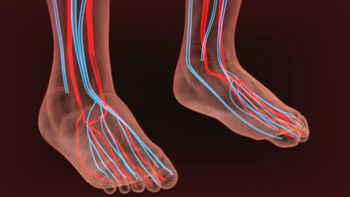Peripheral Artery Disease (PAD) is a circulatory issue in which plaque builds up along the walls of your blood vessels, causing them to narrow and reducing blood flow to your limbs. This typically results in leg pain, numbness, or weakness. PAD has become increasingly common, afflicting over 200 million adults worldwide. Left undiagnosed and untreated, PAD can progress to critical limb ischemia, a severe restriction of blood flow to the affected limb, which is associated with a high risk of amputation. Fortunately, there are steps that you can take to lower your risk of developing PAD and its complications, including eating a balanced diet, exercising regularly, maintaining a healthy weight, and getting regular check ups by your doctor. If you are experiencing pain or numbness in your legs or feet, please visit a podiatrist who can perform diagnostic testing for PAD and provide treatment options.
Peripheral artery disease can pose a serious risk to your health. It can increase the risk of stroke and heart attack. If you have symptoms of peripheral artery disease, consult with Dr. Steven Sheridan from Ankle & Foot Specialty Clinics. Our doctor will assess your condition and provide you with quality foot and ankle treatment.
Peripheral artery disease (PAD) is when arteries are constricted due to plaque (fatty deposits) build-up. This results in less blood flow to the legs and other extremities. The main cause of PAD is atherosclerosis, in which plaque builds up in the arteries.
Symptoms
Symptoms of PAD include:
- Claudication (leg pain from walking)
- Numbness in legs
- Decrease in growth of leg hair and toenails
- Paleness of the skin
- Erectile dysfunction
- Sores and wounds on legs and feet that won’t heal
- Coldness in one leg
It is important to note that a majority of individuals never show any symptoms of PAD.
Diagnosis
While PAD occurs in the legs and arteries, Podiatrists can diagnose PAD. Podiatrists utilize a test called an ankle-brachial index (ABI). An ABI test compares blood pressure in your arm to you ankle to see if any abnormality occurs. Ultrasound and imaging devices may also be used.
Treatment
Fortunately, lifestyle changes such as maintaining a healthy diet, exercising, managing cholesterol and blood sugar levels, and quitting smoking, can all treat PAD. Medications that prevent clots from occurring can be prescribed. Finally, in some cases, surgery may be recommended.
If you have any questions, please feel free to contact our office located in Sandusky, MI . We offer the newest diagnostic and treatment technologies for all your foot care needs.

